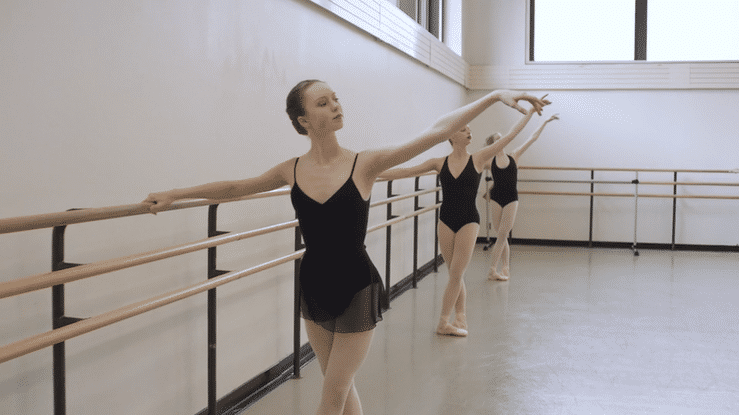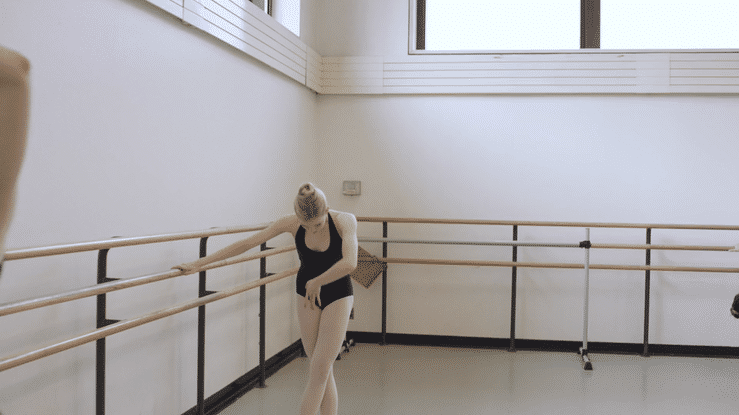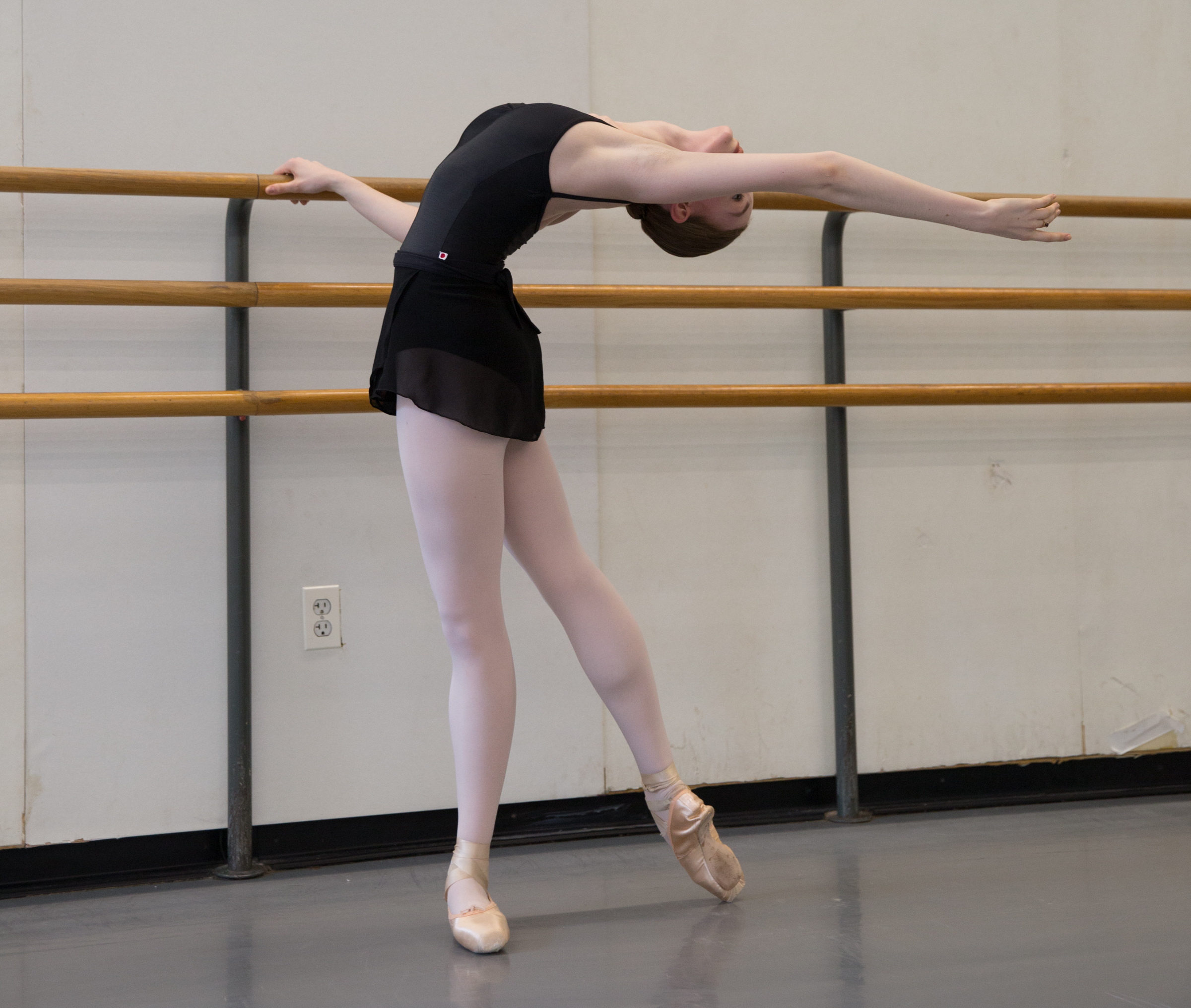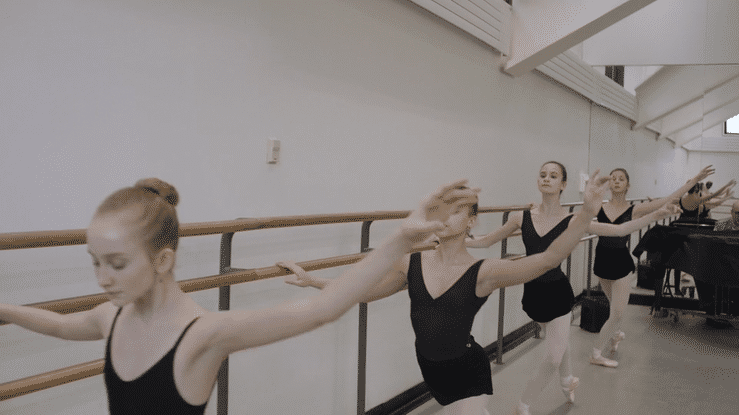In our second installment of Suki Says, we are looking into just one of the many aspects of port de bras Ms. Schorer explains in her book, Suki Schorer on Balanchine Technique — port de bras forward and back.
The English translation of port de bras is ‘carriage of the arms,’ but there is a multitude of variations to how a dancer may carry their arms in ballet. The slight distinctions between the tiniest of details in the placement of the wrist, elbows, neck, and head while executing port de bras can be vast, but it’s all vital to one’s technique. To get a taste of George Balanchine’s preference on port de bras to the front and back, read the excerpt below.

In many classes a port de bras forward and back is given as a stretch, as a moment of relaxation, or as part of getting flexible and warmed up. Class time was far too precious to Balanchine for any of that. We were responsible for being ready to work throughout the class, and we stretched on our own. His exercises were designed to explore the classical technique and to help us refine and perfect our execution of it. They were not intended to make us feel good or to relax us.
When Mr. Balanchine gave port de bras forward and back, he wanted us to perfect a beautifully coordinated and integrated movement. He wanted a continuous flow from beginning to end: from straight, all the way forward through all the way back, and, finally, to straight again.
Standing in fifth with the arm à la seconde, the dancer starts with a breath, making a slight arc with the arm as the back of the wrist lifts while the palm turns to face the floor. The arm starts down, followed by the head and torso – the wrist, hand, and arm lead the body down, rather than the head going first, followed by the arm.

The direction of the hand and arm is down, rather than forward; the hand, leading with the inside of the wrist, aims for the floor about three inches in front of the feet on the center line of the body. The head generally stays straight (rather than tilting to the side) as the hand continues down. The hand comes into the peripheral vision almost immediately, when the body is about a quarter of the way down. When the body is about three quarters of the way down and the hand is fairly near the floor, the eyes focus on the hand.
Sometimes Mr. B would feel that he needed to make this expressive movement more vivid. He would take his keys out of his pocket and put them on the floor three or four inches in front of a dancer’s feet.
“Pretend it’s a flower. Reach down with your hand to pick it up. Look at what you are picking up,” he would say.
After all, when picking something up from the floor, the hand is brought down to it in the most direct path, the arm and hand starting before the head. The chin does not lead the way; the head tilts slightly forward, and the eyes focus on what is being picked up. In most ports de bras it is the wrist that takes the hand into the movement. In this case, it is the inside of the wrist that brings the hand down to the “flower.”
The back does not remain straight; instead, the spine can gently round near the bottom of the bend forward, which can also be viewed as the beginning of coming up. He did not want us to touch the leg with the nose or grasp the ankle with the hand, or place the palm on the floor, any of which might help some people to stretch but none of which makes for a unified, aesthetically pleasing gesture or is attractive to see.
The dancer does not start up by lifting the head and/or arm away from the legs while maintaining a straight back. Coming up, she starts by gently rolling through the spine, with the arm following, raising her head and eyes to watch her hand, or that “flower.” The elbow bends as the arm is lifted to fifth high, and her neck is also not rigid and straight.

The port de bras back continues in an uninterrupted movement from the upright position–there is no stop in the movement followed by a little preparatory bend forward before continuing back. The dancer lifts her head up and over to lead into the bend back. The arch is mostly in the upper back as the chest opens and extends. She avoids the tendency to thrust the pelvis forward and let the knees bend.
In many schools the head may be turned or inclined to the side, but Mr. B most often wanted the head straight as it leads up and over and back. The neck is not stiffly held. The arm is usually in fifth high, slightly in front of the face. She watches her flower as she lengthens up to “paint” the ceiling with the back of her hand and continues back. The dancer starts up again with her torso, followed by her neck and head as the arm moves side, remaining slightly ahead of her face and back.
For the port de bras back it is especially important that the dancer does not thrust her pelvis forward and sit into her lower back; instead, she stands as straight as possible and lengthens her back from the base of her spine to the top of her head. As her head leads up and over to the back, she opens her chest, and bends and arches her upper back. She holds the knees stretched and maintains the turnout, keeping a tight fifth position, without rolling in.

Mr. B often gave port de bras as a separate exercise, rather than incorporate it with grand plié or rond de jambe par terre. He also liked to give it from tendu front with plié. The dancer, in tendu front on a straight supporting leg, starts with the familiar breath and a lift in the arm with the palm turning down and then does demi-plié as she starts her arm down, leading with the inside of the wrist, completing the plié when the torso is about halfway down. The hand aims roughly for the ankle of the pointed foot, and the eyes focus on the hand and follow it as it picks up the “flower”; the nose is not brought to the knee. The dancer starts to come up through the back as the supporting leg straightens, coming straight and bringing the hand to fifth high as before. When she does port de bras to the back, she uses the same technique described above. When he gave port de bras in tendu back it was often with a deep, lunging plié. In each case, there was little or no weight on the tendu foot.

Although the movement in port de bras is usually continuous, without any pauses or stops from start to finish, it is not done entirely at the same speed. The dancer must show the beginning with a quicker start, then slow as she continues smoothly down. She does not completely stop when she is down and certainly does not grab her ankle or sweep her hand over the floor.
Coming up, the same principle applies: She starts up quickly and then slows, she starts back quickly and then slows, and so on. To prevent his dancers from creeping down, or relaxing into the movement, or getting sentimental about it, Balanchine advised us, “Faster down, slower up.”
(Schorer, 1999, p.133-136)
|
Essential Details on Port de Bras Forward and Back
Don’t reach away
Keep the arm in front of the body on the way forward and down; not body and head first, then arm
Keep the head straight forward, rather than turned to the side
Don’t touch the leg with the hand or head
Come up through the back
Do not allow the feet to roll in when
bending back
Do not let the arm drift behind the back
|
Schorer, S., Lee, C. R., & Rosegg, C. (1999). Suki Schorer on Balanchine Technique. A.A. Knopf.







